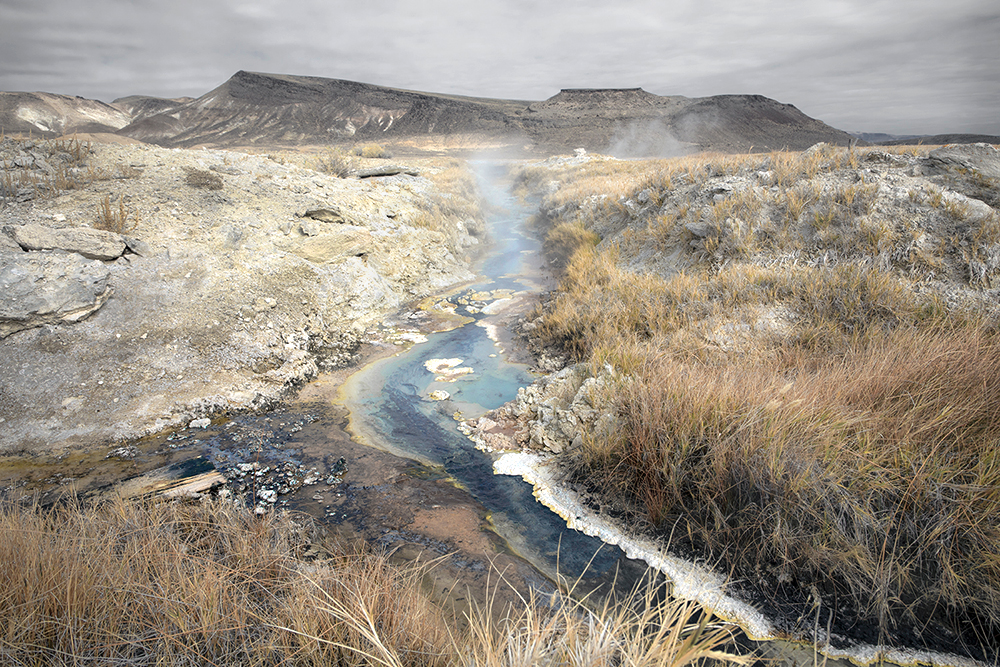Earth Week: Bremner Benedict: Hidden Waters
The bodies of work that I will be sharing during Earth Week are linked by this thematic lens: making the often-invisible nature of the global climate and the ecological crisis more visible using conceptual, lens-based art techniques. Each body of work speaks to a different aspect of the climate and ecological crisis: loss of place; waste; sea level rise, plastic pollution, industrial meat production, desertification, and fire. These bodies of work seek to uncover the hidden interdependence of both social and natural systems and challenge us to re-examine our relationships with each other and this planet.
Bremner Benedict’s projects center on exploring the disconnect between humanity and nature. In 2015, Benedict began Hidden Waters, a series that combines art and science focusing on natural springs in the American West. Recent awards include Conversations with The Land, Juror’s Award, Center for Fine Art Photography, 2021, Massachusetts Cultural Council Finalist, 2021; Critical Mass Top 200, 2019; two Puffin Foundation Grants; Her portfolios are in Fidelity Art Boston; Center for Photography, Tucson; Decordova Museum, Lincoln, MA; solo exhibitions include Florida Museum of Photographic Arts; Texas Woman’s University, Denton, TX; Toronto Globe & Mail published an article: Hidden Waters, 14/08/2022.
Follow Bremner Benedict on Instagram: @bremnerbenedict

©Bremner Benedict, Telephone Pole in Artesian Spring-fed in Wild & Scenic Amargosa River, Mojave Desert, CA
Hidden Waters
Since prehistoric times springs have been key to humanity’s survival. Unfortunately, arid and semi-arid land springs, cienegas, and their aquifers in North America are endangered and disappearing at a rate that continues to increase as the water crisis in the West prevails across lands that are the driest they have been in 1,200 years. Being an artist who is passionate about the water crisis in the West, I am drawn to their story as unseen yet essential details whose importance is misunderstood.
Living on the Colorado Plateau I was struck by the contrast between spring-fed oases and their parched surroundings. I noticed how a landscape of drought and aquifer overuse can drain color out of the environment. The toned colors of Maynard Dixon’s Western landscape paintings provided my inspiration to use color and mood to imply the vulnerability and precarious future of dryland springs. This series is an intersection of art and ecology where I interpret scientific data visually and viscerally to humanize its complexity, while at the same time addressing a wider view of climate change and its impacts on dryland springs by making them feel accessible and personal in order to encourage their stewardship.
Currently there is a lack of public information on the importance of these waters and the need for their protection; conservation is inconsistent at best. Springs continue to hold vital clues to the health and longevity of the underground aquifers we depend on, and the loss of these significant ecosystems will continue to threaten our ability to live in dry places. If we want any chance to combat the climate crisis, then the importance of documenting these ecological sites before they are gone, and capitalizing on these opportunities to raise awareness, cannot be understated. -Bremner Benedict

©Bremner Benedict, Barbed Wire Fence at the Restored Blue Hole Cienaga, Chihuahuan Desert, New Mexico

©Bremner Benedict, Burned Board from Former Exploratory Mine, Pinto East Hot Springs, Black Rock Desert, Great Basin, Nevada

©Bremner Benedict, Captured Spring Water Storage for Livestock Watering and Fire Suppression, Pat Tub #1, Colorado Plateau, Arizona

©Bremner Benedict, Remnant Pipe from Abandoned 1800’s Trading Post, Used by Local Ranchers When Needed, Moenave Road, Dine Nation, Arizona

©Bremner Benedict, Restored Spring Pool in the Last Intact Oasis in Death Valley, Longstreet Spring, Ash Meadows, Mojave Desert, Nevada
Posts on Lenscratch may not be reproduced without the permission of the Lenscratch staff and the photographer.
Recommended
-
Nathan Bolton in Conversation with Douglas BreaultJanuary 3rd, 2026
-
Salua Ares: Absense as FormNovember 29th, 2025
-
Ricardo Miguel Hernández: When the memory turns to dust and Beyond PainNovember 28th, 2025
-
Pamela Landau Connolly: Columbus DriveNovember 26th, 2025






























































